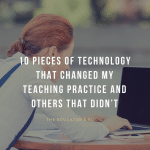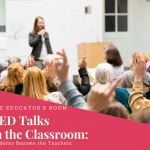Ready or not, my rural high school is preparing to deliver 1:1 iPads to our entire middle and high school populations next fall. Furtive conversations abound in halls and at lunch gatherings as we debate the possibilities and traditional needs of classroom learning. There has always been a fine line between reliance on products that facilitate 21st century learning or teaching as salespersons for product placement. Are we building a service based society at the expense of academic learning? What about our rural students? Does reliance on iPads alienate them or become enhancers their talent? I’m wracking my brain over these questions; I dare not get the answers wrong. My excitement and anxiety is compounded by my husband’s responsibilities for said project. He is the tech integrationist, a stand up teacher who sacrificed his classroom role to lead this initiative. We have much at stake in this, including a dinner date a year from now.
Teaching in a classroom with equitable digital technology allows students access to more information than I can control. They will be multitasking, they will be distracted from learning and this will be cause for conflict if I continue in the traditional sense. Whereas a lack of planning creates an environment with little student investment, the simplest management can present students with reason for investing in their own potential.
Paperless– Among my peers the debates revolve around having a paperless classroom, a selling point for technology for as long as I can remember. ITSE published a yes/no analysis that presented practical considerations. General communications with parents or students improve with less paper waste. Email or push notifications are great for reminders or redirection to itineraries and Twitter is very handy in this use. I am someone who benefits from push notifications from calendar appointments. Next year I plan to have students develop daily routines: open calendars, review the itinerary, click on surveys and formative questions. Students will access readings and handouts through readers or pdf which should save me time spent at the copier. When paper copies are needed they can be printed out of necessity instead of excess.
Paper cannot and must not go away. I have heard parents worry aloud that students are engaging in collaborative projects at the cost of writing. Handwriting is vital to foundational literacy and developments of fine motor skills, it is how students decode. Reliance only on applications and spellcheckers weakens skills for deciphering multi-syllabic words and content rich text. Students need to manipulate language structures kinesthetically and paper is that useful technology. Years ago, I was impressed by an unobtrusive glass case in the foyer of West Point. The writings and art sketches of former students Ulysses Grant and Robert Lee were displayed as proof that the arts and academia were as crucial to war as firearm accuracy. There is still a minimum expectation to being able to present with clarity, the potential location for a battle site on paper. (ps- Lee was the stronger student). While ideas fill tangible spaces around us paper collects, holds and exhibits.
Notebooks– Not having a notebook is like designing fashion without models to wear the clothing. Another metaphor it as the base camp for mountaineers, holding the restorative fuel and proof of the adventure. Students need a tangible portfolio/binder of their course knowledge. For years I have had students keep classroom binders for quick reference guides, reflections and geographic studies not knowing that Interactive Notebooks exist in numerous examples on Pinterest and other publications (Kenney). Students should keep work both on iPads and in class. They can pick and choose templates from applications (notability, pages, Inspiration) to create professional notes that are actually published for classroom use. Common Core expectations for writing tend to push students away from recall and knowledge collection towards analysis and development of word consciousness for a variety of purposes and audiences. That first audience is the classroom.
Textbooks and primary source documents have a place in an iPad classroom. When the cloud is full or the internet is spotty, textbooks can be read by anyone at anytime. Juxtaposed with E-literature gives students the role of critic, comparing what was left out or how well it presents a point of view. Multiple experiences with variety of text is essential for struggling readers and the iPad can assist. My daughter uses hers as a timer for her three minute math. What if the homework was to not to read and finish a chapter but to read for time? What if students reread a piece, focusing in the habits of reading and fluency instead of surveying content? Would the conversations in class be richer? Would they read more often?
Flipped student- I have observed a variety of flipped classrooms and have spent hours making videos of my own. It occurred to me that students could engage in similar practice. The music teacher at our school currently relies on parental signatures to document weekly practice logs. We discussed having students videotape their practice to post for a weekly review. They could pick one best piece or one particular struggle. They would be building a portfolio and self monitoring their progress. In English or social studies flipped students could submit one minute readings of text for fluency. Hearing a student read aloud shocks and enlightens teachers to the sincere need for teaching reading strategies instead of plowing through content.
Testing– I love when students come into class demanding answers to questions on an online test. Posting tests as instantly scored online homework helps me focus on what I should reteach before I walk in the door (Socratize is a great testing app). Students sincerely ask and answer a more challenging question especially if there is an allowance to take that test multiple times.
1:1 iPads is going to be an experience. I do not see it as a threat to the traditions of face to face conversations but believe it will foster considerate attention to integration and celebration of student work.





Bad, bad idea!
I am fortunate to have recently won a class set of laptop computers, and I am amazed that I have experienced everything you’ve mentioned. I am thrilled to be breaking ground in my county with 1:1 technology. I am also sure that paper, pencil, and real books still have a place in my classroom, Near the end of this school year, our network connection was spotty at best. I had to step back, pull out the texts, and have students write on paper. We laughed about how we had become so reliant on the computers that we groaned when we had to go back to the “old” ways. I am so looking forward to seeing what I can create to enhance my students’ learning during this next year.